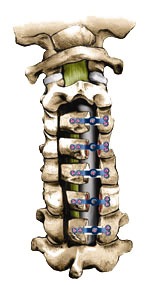Laminoplasty
A cervical laminoplasty is a spine surgery that involves reshaping/repositioning bone to relieve excess pressure on the spinal nerve(s) in the cervical spine, or neck. A cervical laminoplasty is often performed to relieve the symptoms of spinal stenosis, the narrowing of the spinal canal.
What Is A Cervical Laminoplasty?
A cervical laminoplasty is a spine surgery that involves reshaping/repositioning bone to relieve excess pressure on the spinal nerve(s) in the cervical spine, or neck. The name of the procedure is derived from the Latin word lamina (thin plate, sheet or layer), and the Greek term plastos (to mold). A laminoplasty differs from a laminectomy in that the lamina is repositioned rather than removed.
Why Do I Need This Procedure?
Spinal stenosis is a condition caused by a gradual narrowing of the spinal canal. This narrowing happens as a result of the degeneration of both the facet joints and the intervertebral discs. The facet joints also enlarge as they become arthritic, which contributes to a decrease in the space available for the nerve roots. Bone spurs, called osteophytes also can form and grow into the spinal canal, and connecting ligaments also may thicken.
These processes narrow the spinal canal and may begin to impinge upon and place pressure on the nerves roots and spinal cord, resulting in such symptoms as
- Neck pain
- Pain that radiates into the shoulders, arms and/or hands
- Numbness, tingling and muscle weakness in the neck and/or upper extremeties
- Bowel and/or bladder impairment
The goal of a cervical laminoplasty is to relieve pressure on the spinal nerves by removing the source of the pressure while still maintaining the stability of the posterior elements of the vertebrae. The procedure also is referred to as an "open door laminoplasty" because it involves "hinging" one side of the posterior elements of the vertebrae and cutting the other side so that it forms a "door" which is then opened and held in place with wedges made of bone and instrumentation.
To determine whether your condition requires treatment with a cervical laminoplasty, your doctor will examine your back and your medical history, and may order an X-ray, computed tomography (CT) scan or magnetic resonance imaging (MRI) scan of your spine. A surgical procedure such as a cervical laminoplasty is typically recommended after non-surgical treatment options, such as medication, rest and physical therapy, fail to relieve symptoms after a reasonable length of time.
How Is A Cervical Laminoplasty Performed?
The operation is performed with the patient on his or her stomach, sedated under general anesthesia.
Through a small incision made at or near the center of the back of the neck, your surgeon will
- Cut a groove down one side of the cervical vertebra(e), creating a hinge
- Cut through the other side of the vertebra(e)
- Remove the tips of the spinous processes, to create room for the bones to pull open like a door
- Bend the back of each vertebre open like a door on its hinge, removing pressure from the spinal cord/nerves
- Remove any other sources of compression i.e., bone spurs, disc material or excess ligament
- Place small wedges of bone in the "open" space of the door, and then secure the door in the open position with instrumentation
- Ease the soft tissues back into place and close the incision
How Long Will It Take Me To Recover?
Your surgeon will have a specific post-operative recovery/exercise plan to help you return to your normal activity level as soon as possible. Following a cervical laminoplasty, you may notice an immediate improvement of some or all of your symptoms; other symptoms may improve more gradually.
The amount of time that you have to stay in the hospital will depend on your treatment plan. In some instances, this procedure may be done on an outpatient basis. You typically will be up and walking in the hospital by the end of the first day after the surgery. Your return to work will depend on how well your body is healing and the type of work/activity level you plan to return to.
Work closely with your spinal surgeon to determine the appropriate recovery protocol for you, and follow his or her instructions "to the letter" to optimize the healing process.
To determine whether you are a candidate for a cervical laminoplasty, please talk to your doctor.
Are There Any Potential Risks Or Complications?
All treatment and outcome results are specific to the individual patient. Results may vary. Complications such as infection, nerve damage, blood clots, blood loss and bowel and bladder problems, along with complications associated with anesthesia, are some of the potential risks of spinal surgery. A potential risk inherent to spinal fusion is failure of the vertebral bone and graft to properly fuse, a condition that may require additional surgery.
Please consult your physician for a complete list of indications, warnings, precautions, adverse effects, clinical results and other important medical information that pertains to the cervical laminoplasty procedure.
